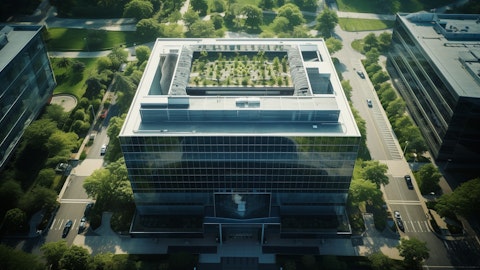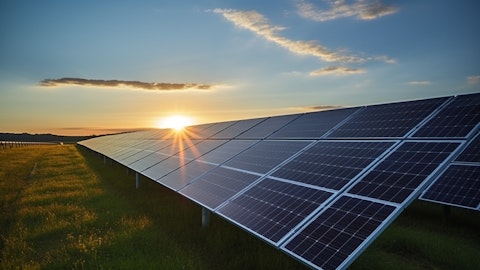Willdan Group, Inc. (NASDAQ:WLDN) Q2 2025 Earnings Call Transcript August 8, 2025
Operator: Greetings. Welcome to Willdan Group’s Second Quarter 2025 Earnings Results Conference Call. [Operator Instructions] As a reminder, this conference is being recorded. It is now my pleasure to introduce Al Kaschalk, Vice President. Thank you, sir. You may begin.
Albert Leo Kaschalk: Good afternoon, everyone, and welcome to Willdan Group’s Second Quarter 2025 Earnings Call. Joining our call today are Mike Bieber, President and CEO; and Kim Early, Executive Vice President and CFO. Our conference call remarks will include both GAAP and non-GAAP financial results. Reconciliations between GAAP and non- GAAP measures can be found in today’s press release and in the presentation slides, all of which are available on our website. Please note that year-over-year commentary or variances on revenue, adjusted EBITDA, adjusted EPS discussed during our prepared remarks are on an organic basis. We will be making forward-looking statements about our performance. These statements are based on how we see things today.
We may elect to update these forward-looking statements at some point in the future. We do not undertake any obligation to do so. As described in our SEC filings, actual results may differ materially to risks and uncertainties. With that, I’ll hand the call over to Mike, who will begin on Slide 2.
Michael A. Bieber: Thanks, Al, and good afternoon. We had another strong quarter of performance, capping a record first half in 2025. In the second quarter, we continued to execute very well, delivering results that exceeded the Street expectations and our own forecasts across revenue, adjusted EBITDA and EPS. Our formula for catalyzing organic growth with the capabilities of new acquisitions is working. Against a strong Q2 last year, net revenue grew 31% year-over-year, driven by an outstanding 23% organic growth rate and 8% acquisitive growth. Performance remained strong across all business lines, reflecting the consistency of our execution and the value of our integrated model, with electric load growth expected to increase over the next decade, driven by data centers and electrification, Willdan’s differentiated capabilities position us well to sustain long-term growth.
As a result, we’re raising our full year financial targets, which Kim will present a little later. Turning to Slide 3. Willdan delivers a broad range of energy and infrastructure solutions to commercial customers, utilities and state and local governments. The Energy segment makes up about 85% of our revenue, while our legacy engineering and consulting work makes up about 15%. Demand remains healthy across all customer groups. The 15% of work for commercial customers is mostly centered around electricity usage at data centers, where AI-driven load growth is creating significant demand. Willdan is helping technology clients navigate energy constraints, optimize infrastructure and meet aggressive power requirements. Our utility business makes up about 41% of revenue and continues to perform well.
Most of our utility contracts are 3 to 5 years in duration, funded by rate payer fees and continue to provide a strong foundation of recurring revenue. The size of our long-term utility programs is generally increasing across the country as we perform well versus competitors and energy efficiency becomes a power resource. Work for state and local governments makes up 44% of revenue and continues to grow organically at a double-digit pace. Demand from our government customers remain solid and the outlook is positive. Most of our government work is funded through user fees and municipal bonds, which have remained stable. On Slide 4, our upfront policy and data analytics work informs Willdan’s strategy and helps us navigate market change. In our upfront work, we see particular demand for integrated resource planning and asset valuation on projects associated with data center electricity load.
Our upfront work has increased organically at a rate of about 50% this year. These market changes led us to the APG acquisition, which we announced in March that provides deeper solutions for these clients. In Engineering, we saw strong execution and growth, particularly with municipal customers. In Program Management, we performed above our plan on utility programs and building energy programs for cities. Putting this model to work on the right. As an example, we’re hired by technology hyperscalers and their partners to help identify the optimal sites for data centers. This quarter, we rolled out a new proprietary software that we use to help clients site data centers. We think this new software tool is a significant differentiator and provides our clients with minimized interconnect times, lower power and land option costs and faster speed to market.
We then provide clients consulting, engineering and project management to supply the electricity that powers data centers. The new generation of data centers require high-voltage power, often hundreds of megawatts, with a dedicated utilities scale substation and utility interconnect. After a data center is build, we’ll then provide energy optimization inside the data center, as we’ve done for many years. On Slide 5, we have a strong pipeline of opportunities that we’re converting into contracts. These are just a few examples we’ve converted since our last conference call. For a confidential Phoenix Data Center developer, we won a $36 million project to provide consulting, engineering and construction management for a data center substation and interconnect.
For the New York Power Authority, NYPA, we won 2 contracts worth a combined $20 million to provide energy infrastructure upgrades. NYPA has grown to become among our largest customers, and we thank NYPA for entrusting us with these latest awards. We also won another $17 million data center substation project for a confidential client in Sunnyvale, California. We were awarded a $13 million performance contract with the White River School District in Washington State to provide energy efficiency and infrastructure upgrades. We were awarded a $6 million solar generation project in Illinois. And for that same state’s Commerce Commission, we were awarded a $1 million project to evaluate Illinois’s electricity resource adequacy under new load conditions.

The LADWP program previously, our largest contract, restarted finally in July. We don’t expect material contributions from this $330 million 5-year contract in 2025, but the ramp has started. Based on our pipeline of new opportunities and program expansions, we feel good about the outlook for 2026. On Slide 6. From 1970 to 2005, the U.S. experienced several decades of sustained electricity load growth, followed by 15 years of relative flatness. Today, we are in a new era of structural load growth, a trend that is reshaping the electricity landscape. This quarter reflected what we’ve seen over the past few quarters. Demand for our services is expanding across our end markets. The shift towards electrification, coupled with the resurgence in domestic manufacturing and the explosive growth of AI-driven data centers create strong tailwinds for Willdan.
Electricity demand in the U.S. is projected to grow by 50% between now and 2050. And we’re already seeing the front edge of that demand emerge through multiyear infrastructure investments, grid modernization and private sector-funded electricity for data center load. This demand environment supports our belief that Willdan is well positioned to help our clients navigate these changes. We also continue to monitor the uncertainty around tariff risk. While these risks have not had a material impact on our business to date, we remain proactive. We’re working closely with our clients to manage potential volatility, including inserting more flexible contract terms and identifying alternative suppliers for key equipment to mitigate pricing pressure if needed.
While the economic environment remains generally constructive, a recession remains a potential risk. We would not be immune to a broad-based slowdown. But if that occurs, we believe Willdan is relatively well insulated given the funding sources of our core customers, particularly utilities and public agencies. Overall, I’m very pleased with Willdan’s performance. Q2 was solid across the board and forms the foundation for a strong second half and an even stronger 2026. Kim, over to you.
Creighton K. Early: Thanks, Mike, and good afternoon, everyone. Our Q2 results marked the tenth consecutive quarter of significant year-over-year improvement, continuing the trend that began in early 2023. Organic net revenue growth of 23% for the second quarter, the successful completion of recent acquisitions and strong free cash flow conversion attest to the record-setting performance for the quarter and the year-to-date. This momentum enabled us to complete an expansion and extension of our credit facilities and reduced our total debt by $28 million during the quarter, reinforcing our commitment to disciplined capital deployment. With low leverage and strong operating performance, we’re well positioned to continue to invest in growth and development of new opportunities.
Turning to Slide 7. For the second quarter of 2025, contract revenue increased 23% year-over-year to $174 million. Recent acquisitions contributed $11 million to the contract revenue in the quarter. Net revenue grew 31% to $95 million. The recent acquisitions brought 8% of that growth, yielding the organic growth rate of 23%. Growth was broad-based across both segments. Revenue in our Energy segment rose 25%, led by continued strength and funding acceleration in utility programs and double- digit gains in planning and construction management. Engineering and Consulting segment revenues increased 16%, reflecting the continuing municipal demand, geographic expansion and new contract wins. Gross profit grew 40%, with gross margin improving to 39.4%, up from 34.6% last year, driven by a favorable revenue mix and solid project execution.
On the cost side, G&A expenses rose 33%, primarily due to increased wages and incentive compensation aligned with the earnings growth as well as higher stock-based comp linked to the rise in our share price and depreciation and amortization from recent acquisitions. Altogether, higher revenues, favorable gross margin and effective cost control drove a 92% increase in pretax income. Due to the impact of discrete items tied to stock-based compensation and energy efficiency tax incentives, we reported a 52% income tax benefit for the quarter. Net income, thus rose to $15.4 million, up 236% from the $4.6 million we reported in Q2 of 2024. Adjusted EBITDA reached $21.9 million, representing 23% of net revenue, up 71% from a year ago. Adjusted earnings per share more than doubled from — to $1.50 from $0.55 and GAAP earnings per share was $1.03, up from $0.33 a year ago.
This was a record quarter. Now to Slide 8. For the first half of 2025 contract revenue was up 24% year-over-year, while net revenue increased 28% to $180 million. Gross profit increased 31% to $126 million as the gross margin expanded to 38.7%, up from 36.5% last year. Adjusted EBITDA rose 52% to $36.4 million and adjusted earnings per share grew 125% to $2.14 per share. GAAP earnings per share for the first half was $1.36, up from $0.54. All are record numbers for a 6-month period. For some time, we’ve had a goal of achieving best- in-class adjusted EBITDA performance of 20% or more of net revenue. The 23% level for Q2 brings us our adjusted EBITDA margin to 20.2% for the 6 months to date and gives us confidence that we’re on track to exceeding that 20% goal for the first time this year.
Slide 9 outlines our balance sheet and cash flow metrics. We ended the quarter with $28 million in net debt and a net debt to adjusted EBITDA ratio of 0.4x, modestly higher than year-end after deploying $35 million in cash for the recent acquisitions. We had $32 million in cash, $90 million available under our $100 million revolver and available but undrawn $50 million delayed draw term facility, giving us $172 million in total available liquidity at quarter end. Subsequent to the end of the quarter, we reduced the borrowing under our revolver another $10 million, leaving us the full $100 million available at present. In the first half of 2025, we converted 80% of the adjusted EBITDA to cash from operations through a continuing focus on working capital efficiency.
DSO was 70 days, reflecting continued strong collection and disciplined cash management. Free cash flow for the first half of 2025 was $24 million, consistent with the $24 million generated in the first half of 2024. On a trailing 12-month basis, our free cash flow was $64 million or $4.34 per share. Our healthy balance sheet, expanded credit facility and strong operating performance provide us with the financial flexibility to pursue targeted acquisitions and expand capabilities in strategic markets, all while maintaining prudent leverage. Turning to Slide 10. Based on our year-to-date performance, we’re raising our full year 2025 financial targets. Net revenue is now expected to be between $340 million to $350 million. Adjusted EBITDA is now expected to be in the range of $70 million to $73 million, and adjusted diluted earnings per share is projected between $3.50 to $3.65 per share based on an estimated tax benefit of 15% and 15.1 million shares outstanding.
These targets do not include the impact of any future acquisitions. For purposes of modeling, we expect Q3 adjusted EBITDA to be similar to Q2 and Q4 to be slightly less than Q3. On Slide 11, we delivered solid growth and financial performance, and we’re raising our fiscal year ’25 financial targets. We are well positioned in dynamic and growing markets, and we have an active pipeline of strategic acquisition opportunities. We’re excited about the future. Operator, we’re now ready to take questions.
Q&A Session
Follow Willdan Group Inc. (NASDAQ:WLDN)
Follow Willdan Group Inc. (NASDAQ:WLDN)
Receive real-time insider trading and news alerts
Operator: [Operator Instructions] Our first question is from Craig Irwin with ROTH Capital Partners.
Craig Irwin: First, I should start off by saying congratulations. I’ve never seen above 50 in a quarter for Willdan, so you guys are knocking the cover right off the ball. Mike, what stands out is 31% growth and 23% organic growth. Over the last few years, you’ve done a lot of work that I don’t think investors have seen preparing for future growth capacity, the development of the capabilities of your site managers, your engineering teams. And then these recent acquisitions bring in new capabilities, new engineering talent. Can you maybe unpack for us the potential of Willdan to deliver on robust organic growth as we look into ’26 and ’27. Will this require substantial hiring beyond what you’ve put in place over the last couple of years? Are there opportunities for leverage that you’re seeing, maybe new opportunities that you’re seeing with your recent acquisitions?
Michael A. Bieber: Yes, good question, Craig. 23% is one of the best numbers we’ve ever posted, it’s outstanding. And certainly, at this size, we’ve never done anything like that. We’ve worked hard over the last couple of years in intercompany collaboration. When we bring in a new group, a new acquisition, that can catalyze a lot of cross-selling between the new acquisitions capabilities and our legacy clients. And that’s what’s happening in part. The organic growth rate has actually been increasing over the last several quarters. And some of it is due to that cross-selling. We’re in the early stages with APG. That’s a key piece of the puzzle to help clients with data centers and utility clients trying to address these problems, and that has set off a number of opportunities, some of which we listed, many of which are to come later this year and into 2026.
But it’s the cross-selling that is helping to drive our organic growth above any of our competitors’ rates that I have seen, at least.
Craig Irwin: Excellent. And then can you maybe talk about your positioning for work with AEG? Now Willdan over the last several years has had particularly strong relationships with utility commissions as a service provider facilitating energy efficiency, you spent time educating commissions on different technologies and different solutions and helping them understand the returns available. How does this change Willdan or position Willdan for growth on the grid side as your commercial and state and federal customers look to solve these grid problems. I mean, there’s big problems and they need big solutions being. They need companies they can trust.
Michael A. Bieber: Yes. Good question, Craig. You need to have a reputation and be trusted by these large IOUs especially. That’s true for the cities as well. So we’ve got a good background in working for IOUs across the country. And that helps us when we take a commercial plant in for an interconnect or do grid planning work or try to site data centers, we are standing up energy efficiency programs that tend to offset new generation. That reputation of delivering really helps. So it’s been going on for a long time. We really started in California and New York, and now we’re working across the country. It’s helping.
Craig Irwin: And then cash flow has been particularly strong as well these last couple of quarters. I know you do have about 45% fixed price work out there. Can you maybe give us a little color on the character of that work? And going forward is the balance of sort of cost in excess, billings in excess and the cash flow cycle on some of these exciting projects going to be something we’ll have to look closely at? Or is the character of the work that you’re doing something where this is lower risk than some of these very large E&C projects that others tend to complete?
Creighton K. Early: Yes. Well, we do — we are fortunate to get good cash flows from those fixed price projects, you’re right? And they do offer us free opportunity to get paid in advance for work that’s done subsequently and reduce the working capital requirement in the company. And we worked hard on that as well as working hard with our utility customers on faster invoicing and processing of those kinds of invoices. As far as the risk profile of the fixed price contracts that we’ve got, it’s relatively low compared to a classic EPC kind of a contractor. We subcontract, as you know, a fair amount of the work that we do. and the pricing on the projects that we execute in terms of materials is really pretty well handled in advance.
We don’t do a lot of self-performance kind of work where we rely on chubs where we’ve downloaded some of that pricing risk to them. So we feel like that those fixed price contracts are a little less risky than what you might think of the classic EPC contractor. And also part of that, those fixed price contracts are actually service agreements. There’s really no EPC risk involved in some of the work that we do in terms of planning and analytics stuff that is fixed price in nature. And so it’s just based on the scoping of the work that we do. And then typically with the kinds of customers that we worked with for quite some time on projects that we know well. So the downside is pretty small with those. So we’re pretty happy with that. We’re pretty happy with the way that we’ve been able to bring down that overall working capital requirement on the cash flows and I think as you can see from the numbers, we’ve had pretty good success.
Craig Irwin: Understood. Last question, if I may. Obviously, the momentum across your markets is broad-based. It seems like everything is really working for you right now. Can you maybe call out for us any specific elephants that you might be chasing? I know you’ve landed some chunky data center and power opportunities recently. Are there any projects or awards that are potentially $100 million plus that are potential bookings over the next couple of quarters?
Michael A. Bieber: You’re looking into our playbook, Craig? Yes. We’ve got a few of them that we’ve been chasing for quite some time actually, and they have come to maturity. I think it’s likely that you’ll see some announcements. We’ve been chasing an important contract in New York, and I think we’re nearing completion on that one. That’s a nice, big opportunity. And there’s a series of opportunities with some of the RINs in California, we’ve talked about RINs in the prior quarters. Those opportunities are coming out later this year. They’ll probably be awarded either late this year or sometime early in 2026. And those are all nice, big new chunks of long-term contracts.
Operator: Our next question is from Tim Moore with Clear Street Capital.
Tim Moore: Congratulations on the continued organic sales growth and the cross-selling EBITDA margin expansion despite the Los Angeles Water & Power contract, not really kicking in yet. I just want to kind of touch base one aspect, I think maybe similar to cross-selling APG, but a little bit different. The software and analytics side, I mean, you have that gem of a business, the E3 acquisition that you did. So I was just wondering, are you seeing that as a carrot angle really bringing in more penetration getting you into the door at some of these clients to really show them the power support and innovative resource planning? Or is that something you kind of tack on to other existing businesses?
Michael A. Bieber: No, you’re exactly right, Craig. The software offering is now being paired with our services, where we didn’t provide that type of integrated consulting before. And a number of new projects have been awarded over the last, I’ll say, 18 months with that recipe. It’s really working pretty well, pairing the software with the consulting services. We mentioned also earlier, that upfront consulting work grew organically 50% year-over-year for the first half over last half. So it’s on fire. It’s doing exceptionally well right now. We’re adding new capabilities and recruiting a lot of new hires.
Tim Moore: That’s very helpful, Mike. I appreciate that. I just want to just really follow up, I guess, on the broad-based growth question. I kind of asked this last quarter. Considering you have that gap for the Los Angeles Department of Water Power contract pretty much in the first half of this year, is there anything you can pinpoint besides the upfront consulting work? Anything jumping out that you really think is coming back and getting momentum? Does it kind of reconcile a bit more of the organic sales beat in the June quarter?
Michael A. Bieber: It’s tough to do that. We’ve been growing in the teams. We have previously posted individual quarters up in the 20s. This was exceptional. 23% is one of the best numbers we’ve ever posted. And it really was sort of across the board. It was a combination of expanding existing long-term agreements where those big annuity-type IOU relationships increased in volume. It wasn’t a lot of new awards. It wasn’t any single big award and additional cross-selling where we’re pairing our legacy civil engineering work with performance contracting. We won a number of new contracts in Southern California. Also, if you look at the large IOU engagements on the East Coast and on the West Coast, California contracts, especially SCE, those were all significantly up as well. So all of those areas contributed to that 23% outstanding performance.
Tim Moore: That’s terrific color and build conviction for investors. And my last question is I just wanted to follow up a question I asked for Kim, I think last quarter. Tariffs comes up a lot. We know that I think maybe if I got the wrong, equipment materials might be 25% to 30% of your overall contract value from the nonconsulting business side. You have price escalators, you use subcontractors. So is there a chance that you kind of reach the end of this year or early next year where there’s a gap maybe a little bit in the price escalator clauses kicking in for some of the older contracts? I’m just kind of wondering how you deal with that.
Creighton K. Early: Yes. We don’t expect it to have a significant impact obviously this year. But we think we’re pretty well covered from that end. As we move into next year, we do as we indicated, a number of our contracts are going to provide opportunities for us to pass along pricing increases and changing contract terms is going to offer us the opportunity to also update pricing to the extent that tariffs may impact us. It’s not sure, as you’ve seen with the volatility of exactly what those tariffs are going to be or what they’re going to impact. And how much of our equipment is actually imported and subject to those tariffs. But right now, we’re still not considering that to be a major threat to us. I’m sure there’ll be some increases in material costs in some of our contracts, and we may see some impact from those. But as Mike mentioned in his comments, I think that we’re in a pretty good position to manage that risk at the moment anyway.
Operator: Our next question is from Paul Strigler with Satori Capital.
Paul Strigler: Congratulations on another great quarter, well done. Just got a couple of quick administrative questions. I noticed in the one big beautiful bill, the Section 179D tax credit was terminated, or will be wound down sometime next year. And I know, obviously, this quarter, you’ve had a large tax benefit. Can you just talk about what that means going forward?
Creighton K. Early: Yes. Well, that is something that we have seen as well. We’re not happy to see that go away. Obviously, we’re not sure whether it will stay away. There’s certainly going to be efforts see if that provision can be restored. But it will have a significant impact on our tax rate for this year. And we’ll continue to enjoy that benefit really probably pretty much through the end of next year. I think it’s all the projects that get started through sometime in the fall of next year. I can’t remember exactly what month it is. But yes, that will be an impact for sure, if the cancellation of that tax benefit goes away. We’ve been able to enjoy tax benefits in the low teens and the credit, of course, for this year, we would expect the tax rate to be relatively low next year as well, because of that benefit we’ll continue to enjoy.
But if it goes away, we’ll have that higher tax rate, and that’s just something that we’ll have to deal with. But we’re in pretty good shape.
Paul Strigler: And then just I was thinking more about the impact to customer decisions on making energy efficiency upgrades because they — I mean, they lose that 30% tax credit. Was that due to payback periods for some of these projects?
Creighton K. Early: Well, that 30% tax credit is not the 179D. That’s a different issue. But yes, the elimination of the incentives for some of those generating projects, you mean for renewable energies?
Paul Strigler: Yes.
Creighton K. Early: Yes. So it’s a minor issue, I think, for us. That’s not what drives much of the work that we’re doing within our government sector. That’s where we get the benefit from the 179D are generally from government and nontax-paying kinds of clients doing utility scale generation of wind and solar projects, which is where the biggest impact of the cancellation of those investment tax credits is going to impact is a relatively minor part of what we do. We don’t do utility scale generating projects really at all. We’re focused on smaller scale projects that we do as part of our facilities improvement and the infrastructure we do for some of the public entities.
Operator: [Operator Instructions] Our next question is from Richard Eisenberg, Private Investor.
Unidentified Analyst: Congratulations on a great quarter. Are you close to making any more acquisitions this year? And in states like North Carolina, South Carolina and Georgia, is it harder to do business there because the governor is a Republican and he doesn’t have the same policies as the blue states?
Michael A. Bieber: Well, acquisitions. You never can tell when you’re in them, when or if they’ll close. What we can say is that we do have a good pipeline of new opportunities that we’re looking at, evaluating and talking with. So that’s going to play out for us over this year and certainly the first half of next year based on the companies that we’re already generating relationships with. That’s what the M&A pipeline looks like. And it’s likely that over that period of time, we will have acquisitions that make it through our gaps and close. We’ll tell you about them when they do. In terms of North Carolina, South Carolina and Georgia, it’s interesting, actually. We do have a large contract with Duke that serves North and South Carolina, especially and several other states.
And no, it’s not harder to do business there, actually. That contract is doing very well. So sometimes don’t believe everything you read in the newspapers. We read a lot about polarizing policies at the political level, and it generally has very little to do with the actual work we see on the ground. The North Carolina and South Carolina are vibrant markets for us right now.
Unidentified Analyst: Okay. That’s good. Also, if that elimination of the tax credit and the Big Bill, the Big Beautiful Bill, as they call it, if that goes away, like you — how much would your tax rate go back up to right now, it’s about 15%. So how much would an increase if that actually stays law, stays part of the bill?
Creighton K. Early: Yes. Well, that tax rate, that 15% you’re talking about is a 15% benefit, a 15% tax rate. But previously, we were looking at maybe the low teens or mid- kind of teens tax rate. And with the elimination of that we’re likely to get much closer to 20%, somewhere in that kind of a range, I would guess. It varies from year-to-year just based on the square footage of the properties that get completed. So it’s tough to just tie it to a number because it’s tied to — actually to a square footage piece. But it will have a significant impact, I would say, let’s call it 5 points or — in quarter. So on what our effective tax rate would be on a normalized basis. So it’s significant.
Michael A. Bieber: But Richard, you likely wouldn’t see that until 2027 or later. Yes.
Creighton K. Early: ’27, yes.
Unidentified Analyst: Okay. So it wouldn’t go like the 25% or 30%, it would just go from, let’s say, 15% to 20%?
Creighton K. Early: Yes, that would be my best guess at this time as to what we look for. We have other benefits that we get that run through our tax rate as well to arrive at the effective tax rate that we get. But it would definitely increase our effective tax rate over what it would be if 179D stayed in place. It’s significant for us and really helpful.
Operator: We have reached the end of our question-and-answer session. I would like to turn the floor back over to Mike for closing remarks.
Michael A. Bieber: Well, thank you all for attending. We’ll see some of you over the next few months, and we look forward to speaking with all of you next quarter. Thank you.
Operator: Thank you. This will conclude today’s conference. You may disconnect at this time, and thank you for your participation.
Follow Willdan Group Inc. (NASDAQ:WLDN)
Follow Willdan Group Inc. (NASDAQ:WLDN)
Receive real-time insider trading and news alerts





